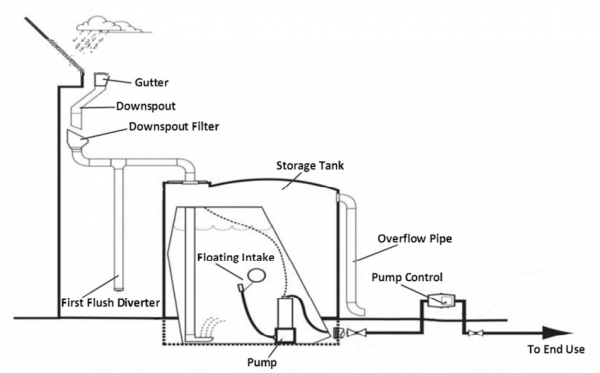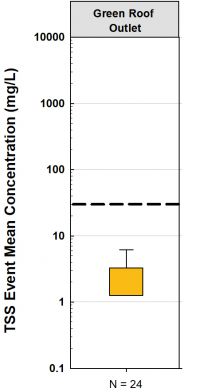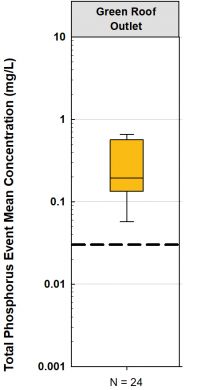Green Roof: Performance
TSS Reduction[edit]
The performance results for Rainwater harvesting practices, located within TRCA's watershed originate from two sites:
- Kortright Green Roof (Vaughan)
- York University (North York)
The mean performance value recorded at each of the green roof facilities, was to measure their ability to remove Total Suspended Sediments (TSS), which was calculated based on 24 separate recordings from 2003-2004, and 2008 at both of the aforementioned locations listed above.
As can be seen in the corresponding boxplot the mean performance removal efficiency of the rainwater cistern practices monitored are well below the suggested guideline of 30 mg/L (Canadian Water Quality Guideline (CWQG), or (background (assumed at <5 mg/L)+ 25 mg/L for short term (<24 hour) exposure) (CCME, 2002[1]; (TRCA, 2021[2]).
The median value of the 24 samples taken was 1.25 mg/L whereas the mean was 2.80 mg/L, with a 0% guideline exceedance.
Phosphorus Reduction[edit]
The performance results for Rainwater harvesting practices, located within TRCA's watershed originate from two sites:
- Kortright Green Roof (Vaughan)
- York University (North York)
The mean performance value recorded at each of the green roof facilities, was to measure their ability to remove Total Phosphorus (TP), which was calculated based on 24 separate recordings from 2003-2004, and 2008 at both of the aforementioned locations listed above.
As can be seen in the corresponding boxplot, the mean performance removal efficiency of the green roof practices monitored is not meeting the acceptable upper extent range of nutrients as it is 0.03 mg/L (30 µg/L) (Environment Canada, 2004[3]; OMOEE, 1994[4]).
The median value of the 24 samples taken was 0.19 mg/L whereas the mean was 0.30 mg/L, with a 100% guideline exceedance. Given the small sample size of just 24 grab samples further monitoring projects will be required to ensure that the results collected are as accurate as possible to ensure these practices can meet federal and provincial governments' guideline requirements for TP stormwater quality. These results were the highest of all practices monitored.
Please refer to the Phosphorus page and the additives page for more information on how LIDs can reduce contaminant loading in stormwater
Recent Performance Research[edit]
- (O'Hogain et al. 2012) - Physicochemical and microbiological quality of harvested rainwater from an agricultural installation in Ireland
- This research study conducted by the Dublin Institute of Technology was commissioned by the federal government to assess the feasibility of utilizing rainwater to replace treated mains for non-potable uses (bathing, irrigation, etc.) on an agricultural property. Two different rainwater harvesting configurations were developed and the results collected over a 1-year period found that median TSS levels were 3.0 mg/L for configuration 1 and 3.5 mg/L for configuration 2. The only parameter that did not comply with local drinking water regulations were the levels of iron, lead and ammonia collected in the cistern of configuration 1 and just ammonia for configuration 2 (O'Hogain et al. 2012[5]).

References[edit]
- ↑ Canadian Council of Ministers of the Environment (CCME). 2002. Canadian water quality guidelines for the protection of aquatic life: Total particulate matter. In: Canadian Environmental Quality Guidelines, Canadian Council of Ministers of the Environment, Winnipeg
- ↑ TRCA. 2021. Spatial Patterns (2016-2020) and Temporal Trends (1966-2020) in Stream Water Quality across TRCA’s Jurisdiction Prepared by Watershed Planning and Ecosystem Science. https://trcaca.s3.ca-central-1.amazonaws.com/app/uploads/2021/10/29113334/2016-2020-SWQ-Report-v11_FINAL_AODA-FA.pdf
- ↑ Environment Canada. (2004). Canadian guidance framework for the management of phosphorus in freshwater systems. Ecosystem Health: Science‐based solutions report no. 1–8. Cat. No. En1–34/8–2004E.
- ↑ Ontario Ministry of Environment and Energy (OMOEE), 1994. Policies, Guidelines and Provincial Water Quality Objectives of the Ministry of Environment and Energy. Queen’s Printer for Ontario. Toronto, ON.
- ↑ O'Hogain, S., McCarton, L., McIntyre, N., Pender, J. and Reid, A. 2012. Physicochemical and microbiological quality of harvested rainwater from an agricultural installation in Ireland. Water and Environment Journal, 26(1), pp.1-6.
- ↑ DeBusk, K. and Hunt, W. 2014. Rainwater harvesting: A comprehensive review of literature. 11-12-W. Water Resources Research Institute of the University of North Carolina.

